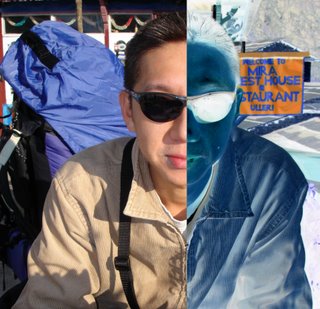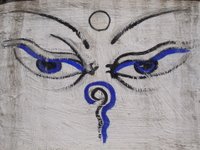 We had planned to visit Nepal in February 2005, however, the king dissolved the government on 1 February 2005, after accusing it on state-run television of failing to conduct parliamentary elections and restoring peace in the country. Flights into and out of the capital of Kathmandu, as well as communication lines, were shut down immediately after the king's national broadcast. This occured a day or two before our scheduled flight date and it convinced us to postpone our trip to a later dat
We had planned to visit Nepal in February 2005, however, the king dissolved the government on 1 February 2005, after accusing it on state-run television of failing to conduct parliamentary elections and restoring peace in the country. Flights into and out of the capital of Kathmandu, as well as communication lines, were shut down immediately after the king's national broadcast. This occured a day or two before our scheduled flight date and it convinced us to postpone our trip to a later dat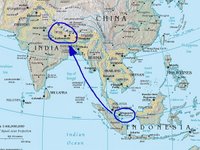 e. Fortunately, our airtickets were valid for a full year (btw, the tickets aren't cheap, a pair of return tickets cost us close to S$1.6k) and we were able to defer it till 2006. Alas, we decided (without much choice anyway since the tickets expire in end January 2006) to give the trip a go again in January 2006.The journey from Singapore to Nepal wasn't very long, however, there was a transit at Bangkok (we took Thai Airway). Upon arrival at Nepal's Tribhuvan International Airport at Kathmandu, we took a cab to Thamel, a popular place for tourists.We found a double room with private bath for US$5. Quite a good price for a basic room, nothing fanciful though (e.g. TV, mini-fridge and bar, coffee & tea making facilities etc.). It was winter time in January, so when the sun sets, tem
e. Fortunately, our airtickets were valid for a full year (btw, the tickets aren't cheap, a pair of return tickets cost us close to S$1.6k) and we were able to defer it till 2006. Alas, we decided (without much choice anyway since the tickets expire in end January 2006) to give the trip a go again in January 2006.The journey from Singapore to Nepal wasn't very long, however, there was a transit at Bangkok (we took Thai Airway). Upon arrival at Nepal's Tribhuvan International Airport at Kathmandu, we took a cab to Thamel, a popular place for tourists.We found a double room with private bath for US$5. Quite a good price for a basic room, nothing fanciful though (e.g. TV, mini-fridge and bar, coffee & tea making facilities etc.). It was winter time in January, so when the sun sets, tem perature plunged sharply. We weren't prepared for such a sharp drop in temperature on our first day there and I was quite underdressed when then sun set. I had a real shock then when the air and surrounding suddenly turned freezing cold! Fortunate, the piping hot vegetable thukpa (Rs30), buff (i.e. buffalo) chowmien (Rs40) and potato & cheese momos (Rs30) saved our shivering bodies.
perature plunged sharply. We weren't prepared for such a sharp drop in temperature on our first day there and I was quite underdressed when then sun set. I had a real shock then when the air and surrounding suddenly turned freezing cold! Fortunate, the piping hot vegetable thukpa (Rs30), buff (i.e. buffalo) chowmien (Rs40) and potato & cheese momos (Rs30) saved our shivering bodies.
The next day, we met up with Santaman Tamang and our porter guide Ram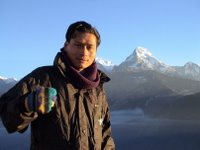 e Tamang. Santaman used to be a tour guide during his younger days, but now he commands a team of guides and porters for his travel & guide services. Rame is his nephew and is among his team of travel guides. Rame is a nice young lad, thoughtful and speaks good English. He grew up in India and is married to a Bhutanese wife, whom he met during university and is a father of 2 when we met him. He hope to make it big like Santaman, with his own trekking company and hotel (btw, Santaman owns the Tibet Guest House, and its quite a big hotel there). He also aspire to climb up to the peak of Mount Everest (soaring at 8848m above sea level). Santaman briefed us on the iteneries of our 14 days trek to Poon Hill and the Annapurna Base Camp (aka ABC). He also helped us to purchase our trekking permits (Annapurna Conservation Permit, Rs2000 each) and bus tickets from Kathmandu to Pohkara (Rs350 each). We set off to Pokhara the next morning. Pokhara is the springboard for trekkers who plan to do either the ABC (10-14 days) or the Annapurna Circuit (21 days) treks.
e Tamang. Santaman used to be a tour guide during his younger days, but now he commands a team of guides and porters for his travel & guide services. Rame is his nephew and is among his team of travel guides. Rame is a nice young lad, thoughtful and speaks good English. He grew up in India and is married to a Bhutanese wife, whom he met during university and is a father of 2 when we met him. He hope to make it big like Santaman, with his own trekking company and hotel (btw, Santaman owns the Tibet Guest House, and its quite a big hotel there). He also aspire to climb up to the peak of Mount Everest (soaring at 8848m above sea level). Santaman briefed us on the iteneries of our 14 days trek to Poon Hill and the Annapurna Base Camp (aka ABC). He also helped us to purchase our trekking permits (Annapurna Conservation Permit, Rs2000 each) and bus tickets from Kathmandu to Pohkara (Rs350 each). We set off to Pokhara the next morning. Pokhara is the springboard for trekkers who plan to do either the ABC (10-14 days) or the Annapurna Circuit (21 days) treks. 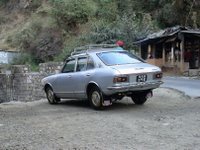 Trekking The Annapurna (Poon Hill & Annapurna Base Camp or
Trekking The Annapurna (Poon Hill & Annapurna Base Camp or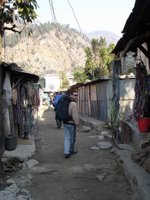 ABC)
ABC)
Our trek began with a cab ride from Pokhara to Naya Pul (Rs750). The village (Naya Pul) was bustling with activities, with rows of shop lining both sides of the trekking path. Along this path, you'll noticed 2 distinct groups of trekkers, those who looked exhausted, tired with droopy eyes and seems to be dragging their foot as they walk. Ah those were trekkers who just completed the trek. The other group however, looked fully energised, excited and seems to be skipping as their walk (that include both of us and Rame). Not much guessing needed here, confirmed they're starting the trek up Annapurna.
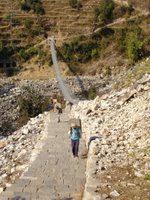 The path began alongside a valley where the Modi Khola river meandered. The next village we encountered was Birethanti. It was here where we crossed the first hanging bridge. From here, we continued our trek along the Bhurungdi Khola river. The view along the path was very good, with waterfalls, grasslands and mountain ranges as backdrops while we breath the cool fresh air around us. There no smog from exhaust pipes of vehicles, no horning and
The path began alongside a valley where the Modi Khola river meandered. The next village we encountered was Birethanti. It was here where we crossed the first hanging bridge. From here, we continued our trek along the Bhurungdi Khola river. The view along the path was very good, with waterfalls, grasslands and mountain ranges as backdrops while we breath the cool fresh air around us. There no smog from exhaust pipes of vehicles, no horning and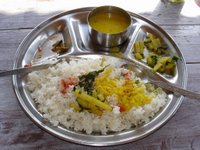 yes, no ringing of mobile phones! Awesome!
yes, no ringing of mobile phones! Awesome!After trekking for a few hours, we stopped for lunch at Muskan Lodge & Restaurant, Sudame. We had our first taste of dhaal bhat (Rs120) in Nepal (in our life to be more exact). Dhaal bhat is a staple food that most Nepali eat. It comprised a generous serving of steamed rice placed on a metal plate. Side dishes always include dhaal, veggie and occassionally with pickled veggie and/or small pieces of meat.
After lunch, we continued our trek passed the Hille and Tikhedhunga villages. Tikhedhunga was an interesting village, with guesthouses towering a number of storeys high and the buildings were tightly packed together.
As we continued past Tikhedhunga, we reached the series of over 4000 steps that leads to Ulleri, where we'd be resting for the night. Climbing the series of steps was gruelling and it seems like they would go on forever, fortunately it was our first day trekking so the zest and energy in us was still very strong. Once we reached Ulleri, we checked in to Mira Guest House & Restaurant. That was our first night stay up in the mountains. It was a great feeling...the cold, peaceful & calm surrounding albeit our tired and sore legs. Its really quite hard to describe how we felt in words, but those who've been there and done that would probably feel likewise too.
The next day, we had a pot of hot milk tea, omelette with tomatoes and 6-grains trekkering bread for breakfast at Mira while savouring the awesome view of the Machhapuchhare (or fishtail) peak in the distant. It was cold in the morning, but the warmth from morning sun was welcoming. Unfortunately, Fiona was down with flu (due to the extreme coldness when the sun sets) since the night before and she felt terrible. After the hearty breakfast, we continued our trek from Ulleri to Ghorepani, our planned stop for today’s trek. Along the trek, we could see the Machhapuchhare peak towering over the other mountains. As we moved on, it became more apparent why the peak was named “fishtail”. We stopped and rested at Banthanti. We’ve also met Nicholas (or Nic which he introduced himself as) from South Africa. His guide was acquainted with Rame, which helped us broke the ice. There was only a lodge cum restaurant there. Our next stop was at Nangethanti, where we had vegetable fried noodles and vegetable fried rice (Rs100 each) for lunch at the Hungry Eye Restaurant. We’ve also spotted a cute young Nepali toddler, apparently the son of the restaurant owner.
From Nangethanti, it was only a 1½ trek to Ghorepani. The day was still early so we slowed down our pace for that short leg of the trek. Initially, Rame, our porter guide was reserve and quiet as he wasn’t familiar with us. But as we became familiar with one another, we found him to be a very friendly chap. Once we arrived at Ghorepani, we checked in to the Kama Lodge & Restaurant. Ghorepani was a large village, due to its proximity to Poon Hill, a popular stop for many trekkers. Fiona’s flu got worse that evening. We had fried noodles with mushroom and cheese (Rs150) for dinner. In addition, with advise from Rame, Fiona also had a bowl of garlic soup (Rs80), which was supposed to aid in her recovery from flu. We had an early night that day cos we need to wake up very early next morning for our trek up to Poon Hill to catch the sunrise.









